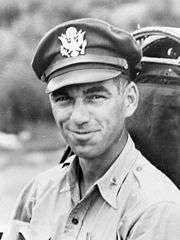Neel E. Kearby
| Neel Ernest Kearby | |
|---|---|
  | |
| Born |
June 5, 1911 Wichita Falls, Texas |
| Died | March 5, 1944 (aged 32) |
| Service/branch | United States Army Air Corps |
| Years of service | 1936–1944 |
| Rank | Colonel |
| Commands held | 348th Fighter Group |
| Battles/wars | World War II |
| Awards |
Medal of Honor Silver Star |
Neel Ernest Kearby (June 5, 1911 – March 5, 1944) was a U.S. Army Air Corps Colonel and P-47 Thunderbolt pilot in World War II who received the Medal of Honor for his actions in combat.
Biography
Kearby was born in Wichita Falls, Texas, graduated from Arlington High School in 1928, and graduated from the University of Texas at Arlington in 1936 (known then as North Texas Agricultural College). He received flight training at Randolph and Kelly Air Force bases.
At the beginning of World War II, Kearby was assigned to Panama where he flew P-39s. He was transferred in October 1942 to Westover Field in Massachusetts to take command of the new 348th Fighter Group with the rank of Major. In June 1943, now a Lt. Colonel, Kearby would arrive in Australia with his fighter group after months of training on the P-47.
The 348th used the P-47's flight characteristics to their advantage. They used their turbo supercharged engines to fly at high altitude to the target and dove on the Japanese planes before firing their eight .50-caliber machine guns on the lightly armored enemy aircraft.
In November 1943, with 12 victories to his credit, Kearby was transferred to the headquarters of the 5th Air Force Fighter Command. Despite his assignment to administrative duties, Kearby still wanted to be in combat. He flew missions whenever he could, and his victory tally continued to rise. For a time Kearby was in competition with Richard Bong to be the leading Army ace of the pacific theater. Like Kearby, Bong wasn't assigned to a combat unit at the time and flew in addition to his assigned duty of instructor in order to stay in combat.

By March 1944, Kearby had 21 kills to his credit. On March 5, 1944, Kearby and two other pilots attacked a formation of 15 Japanese aircraft near Wewak. After shooting down one of the aircraft, Kearby himself was shot down by a Japanese Army Air Force Nakajima Ki-43 Hayabusa fighter. The P-47, his personal aircraft named "Fiery Ginger IV", crashed into the jungle below. Kearby escaped by parachute, but died of his wounds.[1] His remains were found in 1947, but they were left unidentified for two more years. He was buried in Dallas, Texas in July 1949.[2]
Colonel Kearby was one of two U.S. fighter pilots to be awarded the Medal of Honor for actions while flying the P-47. The other was Raymond L. Knight.
Medal of Honor citation
The citation for the Medal of Honor, which was awarded by General Douglas MacArthur, describes his combat heroism:
Place and date: Near Wewak, New Guinea, 11 October 1943. For conspicuous gallantry and intrepidity above and beyond the call of duty in action with the enemy, Col. Kearby volunteered to lead a flight of 4 fighters to reconnoiter the strongly defended enemy base at Wewak. Having observed enemy installations and reinforcements at 4 airfields, and secured important tactical information, he saw an enemy fighter below him, made a diving attack and shot it down in flames. The small formation then sighted approximately 12 enemy bombers accompanied by 36 fighters. Although his mission had been completed, his fuel was running low, and the numerical odds were 12 to 1, he gave the signal to attack. Diving into the midst of the enemy airplanes he shot down 3 in quick succession. Observing 1 of his comrades with 2 enemy fighters in pursuit, he destroyed both enemy aircraft. The enemy broke off in large numbers to make a multiple attack on his airplane but despite his peril he made one more pass before seeking cloud protection. Coming into the clear, he called his flight together and led them to a friendly base. Col. Kearby brought down 6 enemy aircraft in this action, undertaken with superb daring after his mission was completed.
See also
References
- Leatherwood, Art. "Kearby, Neel E.". Handbook of Texas Online. Retrieved 2007-03-18.
- "Colonel Neel Kearby: Fire and Ice And the Race to Become the First Top Gun". Wings of Valor II. HomeofHeroes.com. Retrieved 2007-04-12.
Further reading
- Stanaway, John (1997). Kearby's Thunderbolts: The 348th Fighter Group in World War II. Schiffer Publishing. ISBN 0-7643-0248-5.